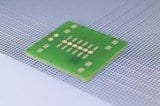Researchers have developed a new kind of anti-theft system, based on a woven fabric that triggers an alarm when penetrated by intruders.
The smart fabric enables the exact location of the break-in to be identified, and is significantly cheaper than other burglary detection systems. It is also suitable as an invisible means of protecting entire buildings.
Thieves are unlikely to appreciate this fabric, which looks innocuous but in fact incorporates a fine web of conductive threads connected to a microcontroller that detects warning signals emitted when the fabric is cut and triggers an alarm. This system can be used to protect buildings, bank vaults, and trucks against even the most wily of intruders. Vehicles parked overnight at truck stops are particularly vulnerable to attacks by thieves who slit open the canvas tarp covering the trailer while the driver is asleep and make off with the cargo. If the tarp were made from the smart fabric, the driver in the bunk would be immediately alerted.
The smart fabric was developed by researchers at the Fraunhofer Institute for Reliability and Microintegration IZM in Berlin in collaboration with the Technische Universität Berlin and ETTLIN Spinnerei und Weberei Produktions GmbH. The company in Ettlingen manufactures technical textiles, among other things, and has filed a patent for the innovative fabric. IZM project manager Erik Simon can envision a whole swathe of potential applications, particularly where there is a need to provide protection over a large surface area. “The fabric could be used to implement an entirely novel, invisible security system for buildings,” he says. For example, the textile could be laid on the rafters of a roof as an additional layer to the vapor barrier underlay, underneath the tiles. This might be a good solution for museums housing valuable collections, or jeweler’s shops, or banks. An alternative solution would be to integrate the fabric in concrete and blockwork walls, for instance those surrounding a bank vault. Another possibility is to use it as a backing material for floor coverings, in combination with pressure sensors that signal an alarm if an unauthorized person enters the room. “The electric current flowing through the fabric is so weak that it presents no danger to humans or animals,” says Simon reassuringly.
Precise identification of the point of entry
What makes this solution unique is the fact that it not only signals the presence of intruders but also indicates the precise point of forced entry. The fine lattice of conductive threads woven into the fabric enables the place where it was cut to be identified to the nearest centimeter. Other solutions currently on the market require a complex system of optical fibers, which naturally makes them more expensive.
There are also other reasons why this fabric is cheap to produce. The process makes exclusive use of standard materials and components such as silver-coated conductive threads and a simple but robust signal evaluation system. A further advantage is that “the conductive thread can be incorporated in the polyester substrate using an industry-standard textile-weaving process,” explains Simon. The result is reams of fabric that can be trimmed to any length and customized to provide the desired functionality for surfaces of any size, from one square meter upward.
via Fraunhofer
The Latest Streaming News: Smart fabric updated minute-by-minute
Bookmark this page and come back often
Latest NEWS
Latest VIDEO








